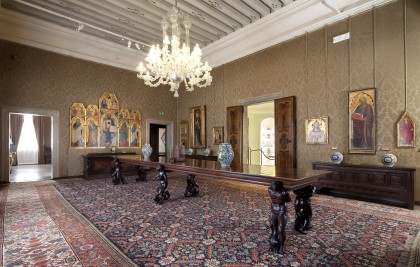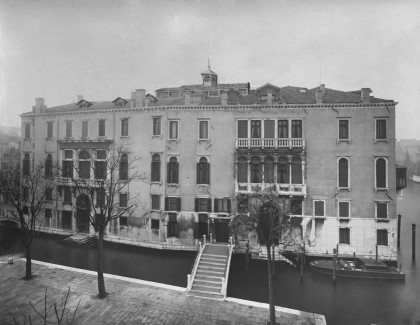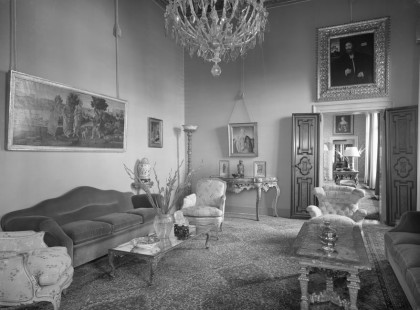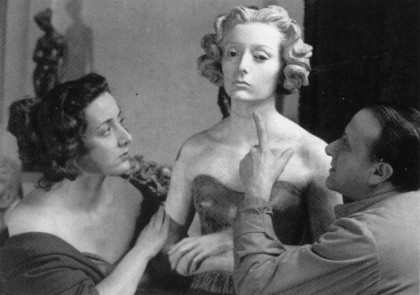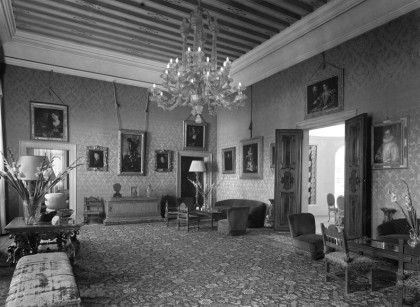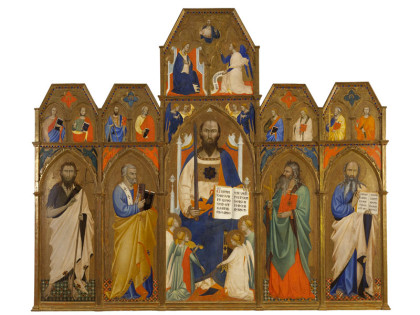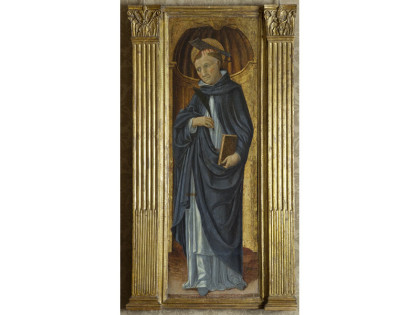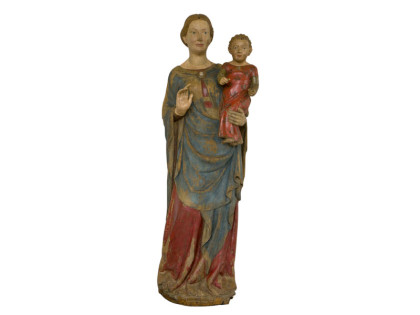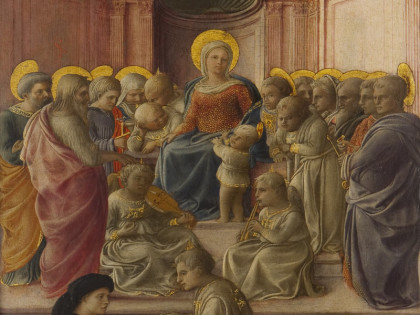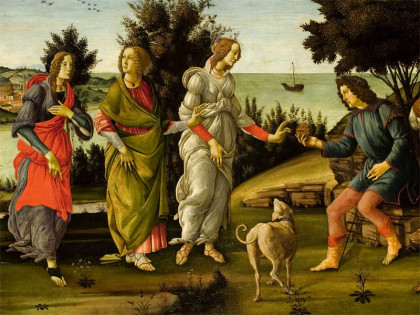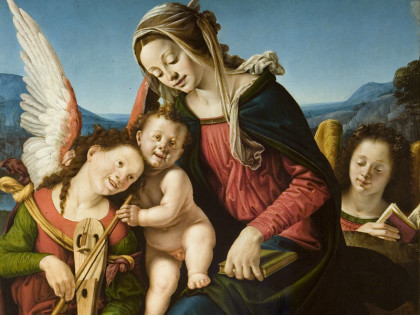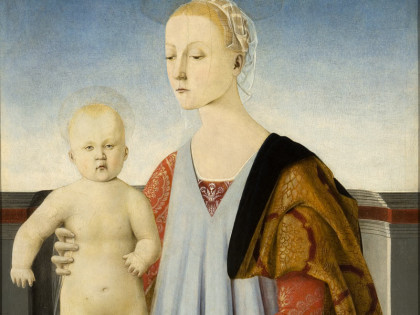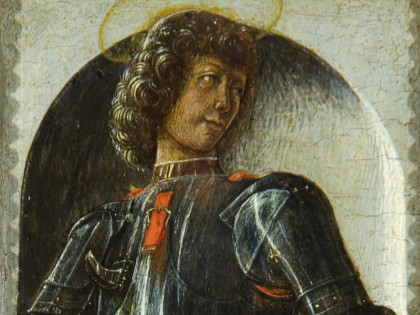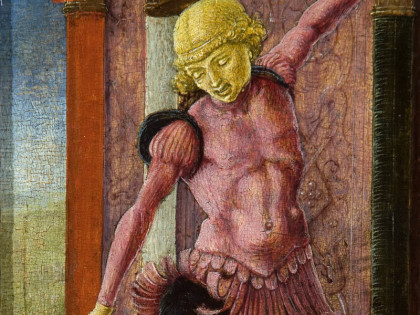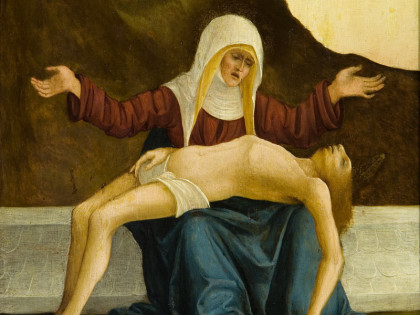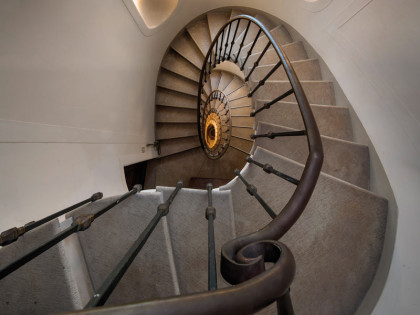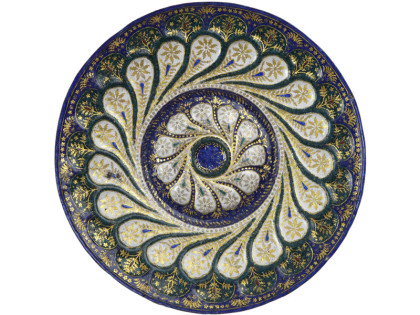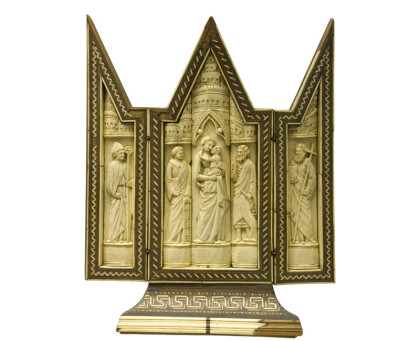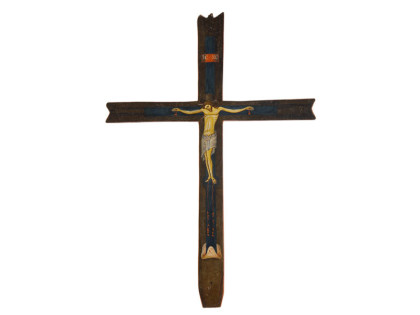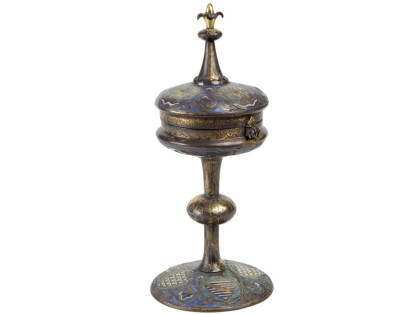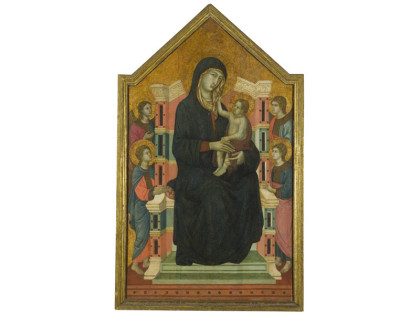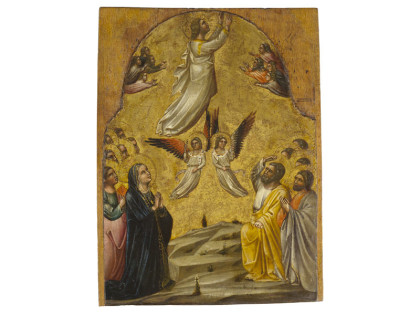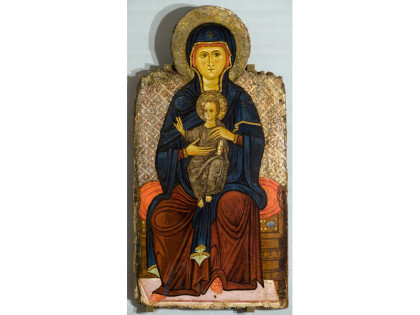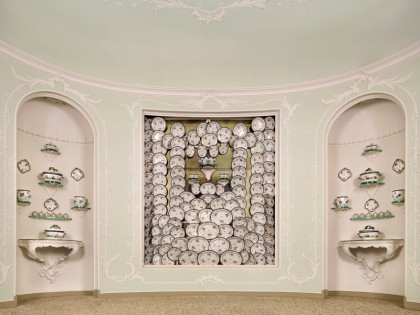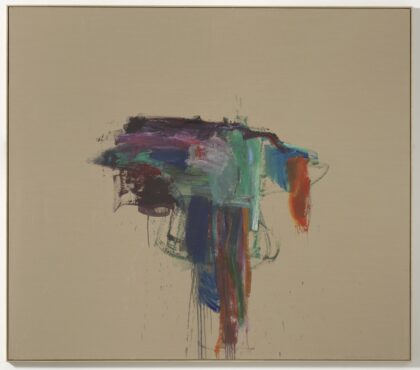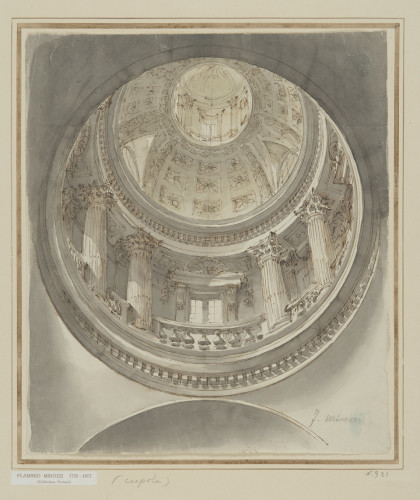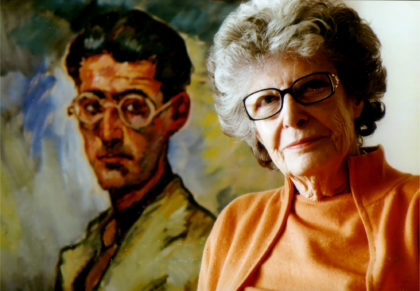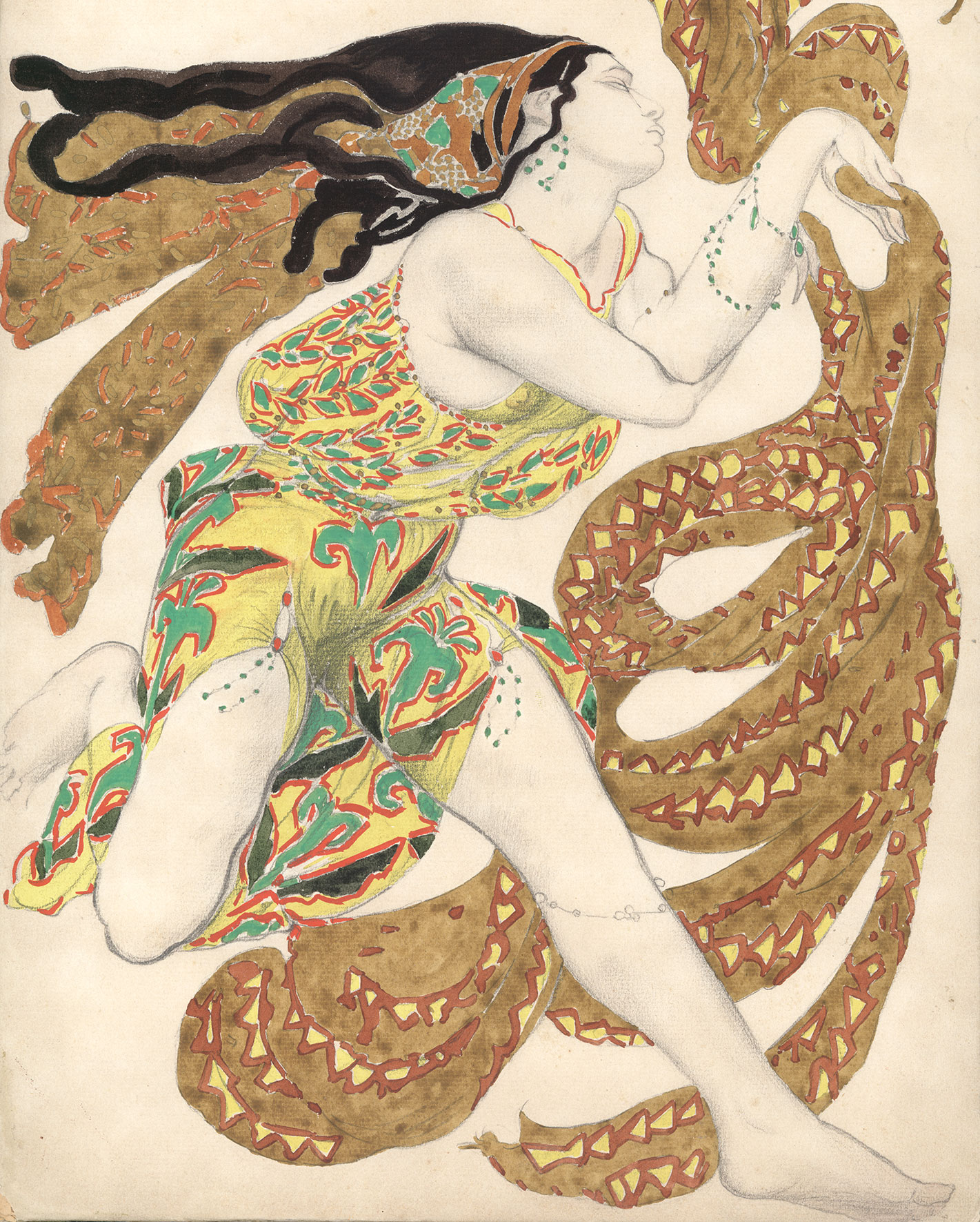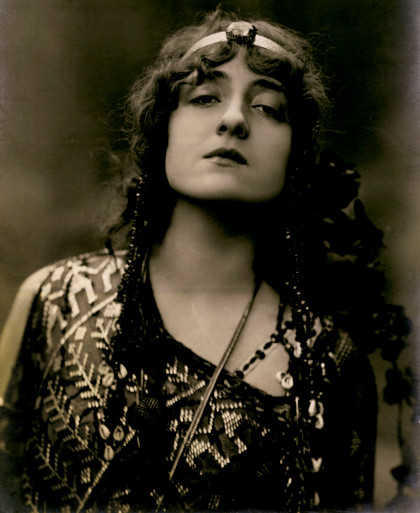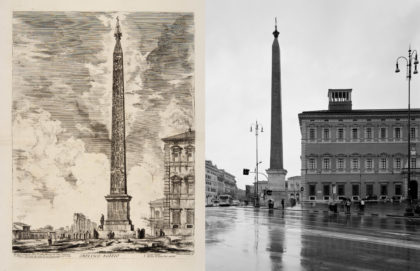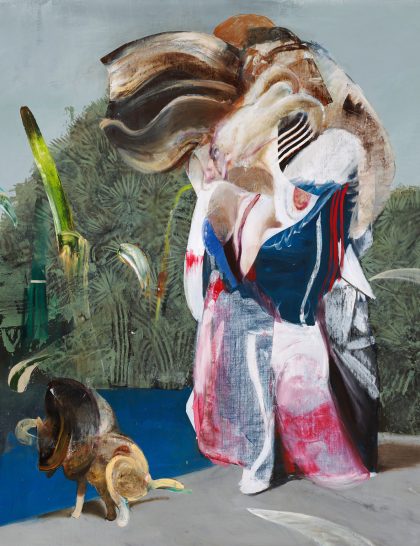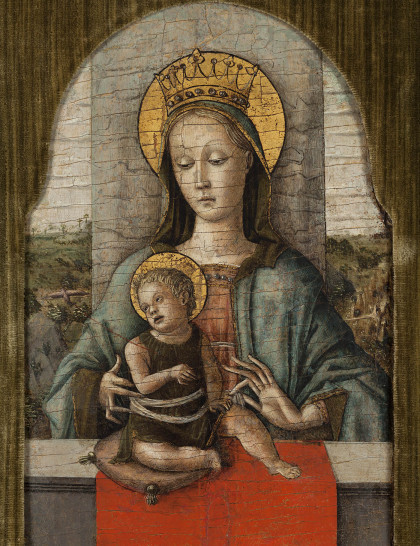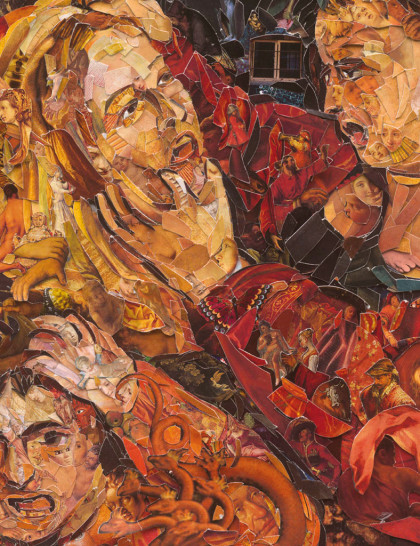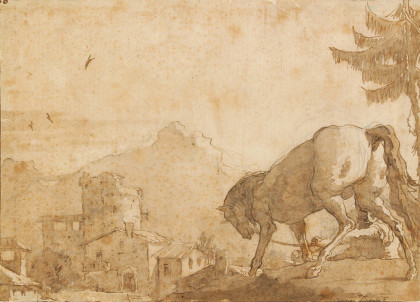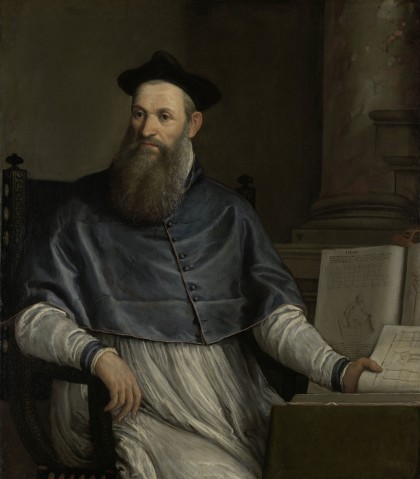Palazzo Cini
The Palazzo Cini Gallery is a refined museum house created in 1984. It contains a significant part of the historic art collection of a leading 20th-century Italian collector: the industrialist and philanthropist Vittorio Cini (1885– 1977).
The Gallery is laid out on two floors: the first recreates the charm of the patron’s residence with fascinating evidence of cultivated collecting in Venice, while the second hosts exhibitions and cultural events. The Gallery was established through a donation by Yana Cini Alliata di Montereale. In 1981 she presented the Fondazione Giorgio Cini with part of her father’s collections and some rooms in the Palazzo Grimani, acquired by Cini with the adjacent Palazzo Foscari in 1919 and 1920. The legacy thus preserved the vital bond between the collection and the house, now re-opened to the public thanks to the support of Assicurazioni Generali.
The donation consists of 13th- to 16th-century Tuscan paintings, sculptures and art objects, such as the outstanding group of Renaissance enamelled copper items, a group of Gothic ivories and the Cozzi porcelain table service laid out in the Neo-Rococo oval room, designed by Tomaso Buzzi. In 1989 an extraordinary collection of Ferrarese Renaissance paintings was added to the initial collection, courtesy of the Ylda Cini Guglielmi di Vulci heirs. In 2015 her heirs further enhanced the Gallery with a new group of art works and furnishings, also once in the original Vittorio Cini collection.
MORE...History
In the collector’s home
Vittorio Cini (Ferrara, 1885 – Venice, 1977) was an entrepreneur and politician involved in the major financial and manufacturing enterprises that drove the development of 20th-century Italy. He was also one of the great 20th-century Italian art collectors.
Vittorio Cini In 1919 he acquired Palazzo Foscari on the Grand Canal, built for Elisabetta Venier Foscari from 1563 to 1565, a year after his marriage to the silent film diva Lyda Borrelli. A few years later it was merged with the adjoining palace, once owned by the Santa Maria Formosa branch of the Grimani family and originally built for for Vincenzo Grimani from 1564 to 1567. In Venezia città nobilissima et singolare, Francesco Sansovino described by the Palazzo Grimani as being of a “beautiful and gracious style”. The spacious residence became increasingly important, especially due to Vittorio Cini’s need for official reception rooms, especially after he was made a Senator in 1934. And so the palace became a treasure trove of paintings, sculptures, glass works, porcelain, enamels, small bronzes, rugs and mirrors, arranged according to the principles of aristocratic elegance and care over quality so as to immediately convey the image of a wealthy, knowledgeable gentleman.
Cini’s collecting spirit inspired the layout of the palazzo at San Vio, chosen to host the finest items from his immense, ever-growing collection, which by the 1940s and ‘50s had reached qualitative standards that very few similar Italian collections could rival: paintings, sculptures, glass works, porcelain, enamels, small bronzes, rugs and mirrors. Cini usually acquired these objects on the best antiquarian markets, relying on the services of a group of advisers, connoisseurs, specialists and art historians of the calibre of Bernard Berenson, Federico Zeri, Giuseppe Fiocco and Tammaro De Marinis, the leading arbiters on attributions and Italian art history culture at the time. In the 1950s the collections in the palace were re-organised to improve the display of the paintings, which in the meantime had grown greatly in number.
From 1956 to 1958, the Valtellinese architect Tommaso Buzzi (Sondrio, 1900 – Rapallo, 1981) – a key figure for a large clientele of aristocratic patrons wishing to modernise their private homes – was asked to design the interiors of the Cini residence in Venice. His two most significant contributions can be admired as part of the museum itinerary: the oval spiral stair and the delightful neo-Rococo oval dining room, which occupies the area of the demolished stairway to the piano nobile and showcases the splendid porcelain collection by the Venetian manufacturers Cozzi (1785-1795). As well as being a collector and man of culture, Vittorio Cini also became a patron of the arts and philanthropist. Following the tragic death in 1949 of his eldest son Giorgio, whose private plane crashed near Cannes, Vittorio commemorated him by creating the Giorgio Cini Foundation. A centre of cultural and education, the Foundation was established in 1951 on the island of San Giorgio Maggiore, which consequently hosted institutes of advanced research in humanistic studies, a technical school and a naval college. Thanks to Vittorio Cini’s patronage, the research institutes were soon enhanced with art collections, either acquired on the antiques market as specific endowments related to the academic activities (drawings, antique books and miniatures) or moved to the island of San Giorgio from the family residences.
The Donation
On Vittorio Cini’s death in 1977, the enormous overall collection, divided up into groups according to criteria of geographical areas and schools, passed to his daughters Yana, Ylda and Mynna.
The third-born Yana, who in 1953 had married Prince Fabrizio Alliata di Montereale, inherited the section of paintings from Tuscany and Central Italy. She then decided to donate a large group of them along with some fine sculptures and various items of decorative arts to the Giorgio Cini Foundation, thus laying the basis for a public gallery reflecting the great patron’s collecting spirit, taste and passion within the institution that he had created in 1951. In 1981 and 1982 the deeds of donation were drafted and they included part of the family palace. This farsighted thinking guaranteed the possibility of maintaining intact the vital bond between the art works and their setting. On 21 September 1984 the Palazzo Cini Gallery was inaugurated in a ceremony attended by Federico Zeri, who had curated the exhibition installation and edited the catalogue.
This initial core was then enhanced in 1989, when the Cini Guglielmi di Vulci heirs generously permanently loaned a large collection of Ferrarese paintings. Built up by Cini by virtue of his Emilian origins and preferences, this collection had been inspired by the presence of the significant figure of Nino Barbantini, who had organised a major exhibition on Renaissance Ferrara in the Palazzo dei Diamanti in 1933.
The Gallery
Conceived as a museum house thanks to exhibition design criteria that respected the nature of the collector’s home, the gallery exhibited the invaluable group of paintings, sculptures and art objects in a significant itinerary representing Italian art from the 13th to the 16th century. Moreover, the gallery is unique on the Venice museum scene because of its large number of “Tuscan Primitives”, which can only be rivalled by the collection in the Galleria Giorgio Franchetti at the Ca’ d’Oro. The donation included a remarkable series of paintings from Renaissance Florence, with masterpieces by Filippo Lippi, Fra Angelico, Botticelli, Piero di Cosimo and Pontormo. These works have been celebrated in the literature and recently exhibited to the public in a number of major international exhibitions.
The Ferrarese Room features some of the finest items from the Estense Renaissance collection, including masterpieces by Cosmè Tura (a panel from the Colonna altarpiece), Ercole de’ Roberti − three small panels from the Griffoni Polyptych, once in the homonymous chapel of the church of San Petronio, Bologna − and works by other artists active in the “Officina ferrarese”, such as Marco Zoppo, Baldassarre d’Este, Ludovico Mazzolino and Lorenzo Costa. The highlight of the series, however, is the panel with an Allegorical Scene by Dosso Dossi, once part of the ceiling in Alfonso I d’Este’s bedroom in the Estense Castle, Ferrara. The collection of paintings is complemented by various groups of decorative arts of very fine workmanship: French, German and Sicilian-Byzantine ivories; four bone artefacts with wooden inlays made by the Workshop of the Embriachi; the admirable series of Renaissance enamelled copper objects made in Venice; a 13th-century Limousin champlevé enamel pyx; the stunning 18th-century Cozzi hard-paste porcelain table service; not to mention cassoni and furnishings, including an 18th-century Rococo Neapolitan sedan chair. All testify to the depth and vast range of the great Ferrarese collector’s interests.
The polyptych room
Overlooking the Campo San Vio, this spacious sala is one of the most sumptuous rooms in the palace. Before the death of Count Cini and the conversion of the residence into a museum, it housed a rich collection of Renaissance portraits. Conceived by Cini as a reception room and embellished by glass and porcelain objects, it was the ideal place for “art luncheons” – meetings with art historian and antiquarian friends, during which they discussed potential acquisitions to enrich the collection. The room is characterised by the presence of two large polyptych altarpieces, significant examples of Tuscan figurative art from the late 14th to early 15th century, and an interesting series of paintings with gold backgrounds from the Sienese Quattrocento. The adjoining room is a luminous small oval drawing-room, designed by Tomaso Buzzi, containing an 18th-century porcelain table service made by the Venetian manufacturers Cozzi.
LIST OF WORKS
- Francesco Neri da Volterra(1343 – 1371)
Saint John the Evangelist
Tempera and gold on panel
158.5 x 57.8 cm - Master Francesco (circle of Andrea Orcagna)(Florence, c. 1363)
Saint Paul Enthroned with Saints
Tempera and gold on panel reinforced with canvas
225 x 252 cm (overall) - Master of the Silver Crucifix(c. 1350)
Six Saints
Tempera on panel
138 × 58.5 cm - Lorenzo di Niccolò(Tuscany, active 1392 – 1411)
The Virgin and Child Enthroned with Four Saints
Tempera and gold on panel.
central panel: 138.5 × 51.5 cm
left panel: 110.5 × 65.5 cm
right panel: 109.5 × 66.5 cm - Stefano di Giovanni called Sassetta(Cortona, 1400 – Siena, 1450)
The Madonna of Humility
Tempera and gold on panel
79.2 × 46 cm - Master of the Osservanza(Siena, first half 15th century)
Christ the Redeemer
Tempera and gold on panel
74 × 60.6 cm - Lorenzo di Pietro called Vecchietta(Castiglione d’Orcia, 1410 – Siena, 1480)
Saint Peter Martyr
Tempera and gold on panel
195 × 104.5 cm - Matteo di Giovanni(Borgo San Sepolcro, 1430 – Siena, 1495)
The Virgin and Child with Two Saints
Tempera and gold on panel
63 × 44 cm - Sienese sculptor(second half 14th century)
Bishop Saint
Polychrome wood
158 x 36 cm - Circle of Francesco di Valdambrino(15th century)
The Virgin and Child
Polychrome wood
150 x 40 cm - Cozzi Manufacture(Venice, second half 18th century)
Table service
Porcelain, 275 pieces
- Francesco Neri da Volterra(1343 – 1371)
The renaissance room
The room featuring Tuscan Renaissance masterpieces, for which the Palazzo Cini is rightfully renowned, was used by Vittorio Cini as a small drawing room for illustrious guests and so even in his day it was adorned with some of the best paintings in the collection. The current exhibition installation still reflects the original feel of the room thanks to Princess Yana Cini Alliata di Montereale, who presented the Foundation with many of the valuable works still on show here, such the Judgement of Paris by Botticelli and his workshop, a Madonna and Child by Piero della Francesca and Piero di Cosimo’s magnificent Virgin and Child with Two Angels.
Cini’s predilection for the Renaissance is demonstrated not only by the presence in the collection of paintings on panel from a broad geographical area mainly comprising Tuscany and the Veneto (Crivelli, Montagna, Bellini and Cima da Conegliano). There are also Renaissance works from Ferrara, Romagna and southern Italy (Antonello da Messina and Colantonio), as well as large group of 15th-century wooden statues and polychrome terracotta works attributed to the workshops of Ghiberti, Donatello and Jacopo della Quercia, plus items by Luca della Robbia, small bronzes and ceramic objects. The works were acquired from the usual reliable antiquarian sources and private aristocratic collections, such as those belonging to the Dukes of Torlonia in Rome (the painting by Piero della Francesca), the Caregiani Counts in Venice (Domenico Ghirlandaio’s roundel), the Guicciardini Counts in Florence (their collection once included the supreme Cini Gallery masterpiece – the Portrait of Two Friends by Pontormo).
This is the only room with a wall decoration: a 16th-century grotesque-motif frieze runs round the room beneath the ceiling. An interesting vestige of the Palazzo Grimani, the frieze was spared when almost all the other walls now in the gallery were covered by a damask fabric.LIST OF WORKS
- Filippo Lippi(Florence, 1406 – Spoleto, 1469)
The Virgin and Child with Saints, Angels and Donor
Tempera and gold on panel
47.1 × 36 cm - Fra Angelico(Vicchio, 1395 – Rome, 1455)
Saint Thomas Aquinas
Tempera on panel
39 x 14 cm - Piero della Francesca(Borgo San Sepolcro, 1410/20 – 1492)
The Madonna and Child
Tempera and gold on panel
61.8 × 53.3 cm - Botticelli (and Workshop)(Florence, 1455 – 1510)
The Judgement of Paris
Tempera on panel
81 × 197 cm - Domenico Ghirlandaio and Sebastiano Mainardi(Florence, 1449 – 1494; San Gimignano, 1450 – Florence, 1513)
The Virgin Adoring the Child with Two Angels
Tempera on panel
diameter 31.5 cm - Piero di Cosimo(Florence, 1462 – 1521)
The Virgin and Child with Two Angels
Oil and tempera on panel
116.2 × 85.2 cm - Pontormo(Pontorme, 1494 – 1557)
Portrait of Two Friends
Oil and tempera on panel
88.2 × 68 cm - SculptureGiovanni De Fondulis
(Northern Italy, active 1468 – 1485)
The Virgin and Child
Polychrome terracotta
height 143 cm
- Filippo Lippi(Florence, 1406 – Spoleto, 1469)
The ferrarese room
This room contains a precious collection dedicated to the Ferrara Renaissance with representative works from the leading artists at the Estense court in the 15th century. Vittorio Cini, who was born in Ferrara, commissioned Nino Barbantini to organise the collections in the palace on the Grand Canal and to refurnish Monselice Castle. An ingenious, indefatigable critic and expert “museologist”, Barbantini had curated a memorable exhibition on the Ferrara Renaissance at the Palazzo dei Diamanti in 1933 and it was thanks to his constant presence and suggestions that the works from the Estense Renaissance school have such a prominent place in the overall Cini collection. The gallery not only features masterpieces by Tura, De’ Roberti, Dosso Dossi and Mazzolino, exhibited here thanks to the generosity of the Cini Guglielmi di Vulci family, but also other Ferrarese works still in the possession of the heirs. They include paintings by the Master of the Twelve Apostles, Garofalo, Panetti, Girolamo da Carpi and Scarsellino.
LIST OF WORKS
- Cosmè Tura(Ferrara, documented 1451 – 1495)
San Giorgio
Oil on panel
21 × 13 cm - Michele Pannonio(Hungary, 1415 – Bologna, 1475)
The Virgin and Child with Saints Nicholas, Jerome, Augustine and Christopher
Tempera on panel
28 x 35.5 cm - Ercole Roberti(Ferrara, 1450 – 1496)
Saint George
Oil on panel
26.3 × 9.3 cm - Ercole Roberti(Ferrara, 1450 – 1496)
Saint Catherine of Alexandria
Panel from the Griffoni Polyptych
Oil on panel
26 × 9 cm - Ercole Roberti(Ferrara, 1450 – 1496)
Saint Jerome
Panel from the Griffoni Polyptych
Oil on panel
26 × 9 cm - Manner of Gian Francesco Maineri(Parma, 1460 – 1506)
The Madonna and Child
Tempera on panel
diameter 45 cm - Marco Zoppo(Cento, Bologna 1433 – Venice 1478)
Saint John the Baptist in the Wilderness
Tempera on panel
40 × 30 cm - Baldassarre D’Este(Reggio Emilia, 1461 – 1509)
Portrait of Tito Vespasiano Strozzi
Tempera on canvas
45.5 × 31 cm - Lorenzo Costa(Ferrara, 1460 – Mantua, 1535)
The Virgin and Child
Oil on panel
57 × 42 cm - Dosso Dossi(? 1489 – Ferrara, 1542)
Allegorical Scene
Oil on panel
107 × 95 cm - Battista Dossi(Ferrara, documented 1517 – 1548)
The Holy Family and the Young Saint John
Oil on panel
50 × 56.5 cm - Ludovico Mazzolino(Ferrara, 1480 – 1528)
Pietà
Oil on panel
30.5 × 22.5 cm - Ludovico Mazzolino(Ferrara, 1480 – 1528)
The Circumcision
Oil on panel
31 × 23.2 cm - Ludovico Mazzolino(Ferrara, 1480 – 1528)
The Presentation at the Temple
Oil on panel
59 × 39.8 cm - Michele Ciampanti(Tuscany, active 1463 – 1521)
Adoration of the Shepherds
Tempera on panel
78.5 × 52 cm - Piero di Cosimo(Florence, 1462 – 1521)
The Holy Family with Saint John
Oil and tempera on panel
118.5 × 87 cm
- Cosmè Tura(Ferrara, documented 1451 – 1495)
Tomaso Buzzi’s oval stair
In the 1950s the architect Tomaso Buzzi (Sondrio, 1900 – Rapallo, 1981) was asked to redesign the interiors of the Cini residence. A key figure for a large clientele of aristocratic patrons wishing to modernise their private homes (Volpi di Misurata, Papadopoli, De Lazara Pisani, Contini Bonacossi and Visconti di Modrone), Buzzi worked for Cini on several occasions, offering his creative flair as early as 1938, when he was responsible for the restoration of the castle at Monselice. The hanging gardens, staircases, terraces and ponds that he designed for the castle look to the tradition of the Venetian villa and already show signs of what was to become his neo-Mannerist style. One of Buzzi’s most significant contributions to the Palazzo Cini can be admired on the museum itinerary: a striking oval spiral stair, with its explicit allusions to illustrious models, such as the scala regia in the Palazzo Farnese at Caprarola del Vignola, Palladio’s oval spiral stair in the monastery of Santa Maria della Carità, Venice and Borromini’s “helical stair” in Palazzo Barberini, Rome.
The antechamber (or sedan chair room)
The visit begins in the antechamber to the apartment. This small room is typical of Vittorio Cini’s refined taste in the decorative art, which always exercised a strong attraction over him, as the abundance and variety of decorative objects in the collection demonstrate. Glancing through the collection inventories, we find numerous ivories, enamels, silver objects, small bronzes, intaglio gems, cameos, glass works and jewels. This shows his interest in small precious objects: some were put away in various corners and then brought out to be shown to connoisseurs and enthusiasts, while other were elegantly set out on small tables, consoles, shelves and glass cases, as is revealed by period photographs. The sample from this very rich collection exhibited here features groups of beautiful Mediaeval ivories and Renaissance enamels. The Antechamber is also adorned by a series of paintings by the Tuscan school, including a 13th-century masterpiece: the processional cross by Giunta Pisano, the highest standard work acquired by Vittorio Cini in the category of the “Italian Primitives”. Until 1937 it had belonged to the Piedmont collector Riccardo Gualino. The room has the intimate warm feel of a formerly inhabited home thanks to the presence of a console with intaglio rocaille scrolls and an 18th-century Neapolitan sedan chair.
LIST OF WORKS
- Giunta Pisano(Central Italy, first half 13th century)
Double-face processional cross
Christus Patiens / Christus Triumphans
Tempera and silver on panel
58.5 × 41.5 cm - Lorenzo Monaco (workshop)(late 14th century)
Crucified Christ
Tempera on panel - Pietro di Giovanni Ambrosi(active from 1428 to 1448)
Crucifixion
Tempera and gold on panel
55.2 × 32.5 cm - Limoges (1270 – 1290)(1270 – 1290)
Pyx
Enamelled copper
height 28.8 cm; cup diameter 11.5 cm - Northern Italy, Venice(late 15th – early 16th century)
Plate
Enamelled copper
diameter 48.5 cm - Northern Italy, Venice(late 15th – early 16th century)
Plate
Enamelled copper
diameter 29.7 cm - Northern Italy, Venice(late 15th – early 16th century)
Cup stand
Enamelled copper
diameter 26 cm height 5 cm - Northern Italy, Venice(late 15th – early 16th century)
Mirror
Enamelled copper
diameter 16.8 cm - Northern Italy, Venice(late 15th – early 16th century)
Plate
Enamelled copper
diameter 29.8 cm - Northern Italy, Venice(late 15th – early 16th century)
Plate
Enamelled copper
diameter 28 cm - Northern Italy, Venice(early 16th century)
Plate
Enamelled copper
diameter 46.2 cm - Venice(second half 17th century)
Mirror
Gilt bronze, copper and enamel
24.6 x 21.5 cm - Workshop of the Embriachi(Venice, late 14th – early 15th century)
Portable altarpiece
The Virgin and Child with Two Angels, Saint Paul and Saint Peter
Carved bone and wood inlays
24.4 x 22.5 cm - Workshop of the Embriachi(Venice, late 14th – early 15th century)
Portable altarpiece
The Virgin and Child with Saints Louis of Toulouse, Lawrence, John the Baptist and Mark
Carved bone and wood inlays
32.8 x 26.2 cm - Workshop of the Embriachi(Venice, late 14th – early 15th century)
Nuptial jewel case
Procession of allegorical figures; Virtues with clubs and shields
Carved bone and wood inlays
28.6 x 16.5 cm; height 22.5 cm - Workshop of the Embriachi(Venice, late 14th – early 15th century)
Nuptial jewel case
Procession of allegorical figures; Virtues with clubs and shields
Carved bone and wood inlays
22.9 x 13.8 cm; height 17.5 cm - Sicily(13th century)
Christ Enthroned
Bas relief on ivory plaque
13.5 x 9 cm - Sicily(13th century)
Adoration of the Magi, Crucifixion, Flight into Egypt, Baptism of Jesus
Pace with 4 bas reliefs
11.3 x 10.5 cm - (second half 14th century)Death of the Virgin and the Dream of Saint Joseph
Ivory diptych
15 x 12 cm - (second half 14th century)Annunciation and Crucifixion
Part of an ivory diptych
5 x 10 cm - France(second half 14th century)
The Virgin and Child, The Magi and The Presentation at the Temple
Triptych
10 x 17 cm - France(second half 14th century)
Cherub Shooting Arrows and Two Couples of Lovers
Part of an ivory diptych
6 x 9.5 cm - France(15th century)
Coronation of the Virgin
Ivory plaque
height 15 cm - France(15th century)
The Virgin with Two Angels and the Crucifixion
Ivory diptych
8.5 x 7.5 cm - Germany(15th century)
The Virgin Mary
Ivory figure
height 19 cm - Germany(15th century)
Saint John
Ivory figure
height 19 cm - Beham Hans Sebald (student of Dürer, attributed)(Germany 1500 – 1550)
The Virgin and Two Angels and The Crucifixion
Diptych
10.5 x 9 cm - Flanders(16th century)
The Virgin and Child
Small ivory plaque with bas relief
45 x 9.5 cm (13.5 cm with base) - Florence(14th century)
Saint Mary Magdalene
Ivory on black marble base
height 23 cm - Francesco Messina(Linguaglossa, 1900 – Milan, 1995)
Bust of Yana Cini Alliata di Montereale
Polychrome terracotta
72 × 51 × 23 cm - Naples(1770 – 1785)
Sedan Chair
Painted and gilded wood with intaglio carving and painted leather
height 191.3 cm
- Giunta Pisano(Central Italy, first half 13th century)
The tuscan primitives room (or maestà room)
The second room in the gallery effectively illustrates Vittorio Cini’s collecting passion for the painting of the Italian “Primitives”, a term coined in the 19th century for those artists who were active just before the great turning point of the full Renaissance, mainly identified with the genius of Raphael. In the first half of the 20th century many collectors in Vittorio Cini’s generation had a deep interest in painting on panel and works with gilded backgrounds from the 13th to the 15th century. This keen interest was directly proportional to the relatively abundant supply of works on the antiquarian market. Hundreds of complete works but also often dismembered pieces from churches, monasteries and confraternities thus considerably enhanced collections, thanks also to the brokering of numerous merchants, agents and restorers. Vittorio Cini’s most influential advisors, capable of cultivating his taste and shaping his choices, included exceptional art historians and connoisseurs, such as Bernard Berenson and Federico Zeri, whose studies and aesthetic preferences for Trecento and Quattrocento painting, especially in Tuscany and Central Italy, conditioned the nature of the collection, which became one of the most important of its kind in the 20th century. This room containing paintings, sculptures and cassoni, is embellished by a 19th-century moulded Murano blown glass chandelier and a delicate neo-Rococo ceiling, made by Giacinto Boccanegra’s team of stucco artists when the palace was being renovated by the architect Tomaso Buzzi.
LIST OF WORKS
- Master of the Bigallo Crucifix(Central Italy, active in the mid-13th century)
The Virgin and Child
Tempera on panel - Florentine School(1375-1400)
Crucifix
Christus Patiens
Tempera and gold on panel reinforced with canvas
210 × 124.5 cm - Giotto (Workshop)(1325 – 1327)
Two Apostles
Tempera on panel
42.5 x 32 cm - Master of the Horne Triptych (Gaddo Gaddi)(Florence, early 14th century)
The Virgin and Child Enthroned with Two Saints
Tempera and silver on panel
182 × 103 cm - Master of Badia a Isola (Siena, active late 13th century)
Maestà
Tempera and gold on panel
172 × 103 cm - Niccolò di Segna(Siena, active 1331 – 1345)
The Virgin and Child
Tempera and gold on panel
76 × 49.5 cm - Taddeo Gaddi(Florence, documented 1332 –1363)
Saint John the Evangelist Drinks from the Poisoned Cup
Tempera and gold on panel
33 × 36.7 cm - Taddeo Gaddi(Florence, documented 1332 –1363)
The Assumption of Saint John the Evangelist
Tempera and gold on panel
33 × 36 cm - Bernardo Daddi(Florence, documented 1312 –1348)
Crucifixion
Tempera and gold on panel
74 × 33.2 cm - Bernardo Daddi (Workshop)The Virgin and Child Enthroned with Saints
Tempera on panel - Master of the Poldi Pezzoli Diptych(Umbria, first half 14th century)
Christ Mocked, The Flagellation and The Crucifixion
Tempera and gold on panel
45.5 x 58 cm - Guariento(Padua, active 1325 – 1375)
The Ascension of Christ
Tempera and gold on panel
28 × 20.8 cm - Florentine sculptor(late 14th century)
The Virgin and Child
Polychrome wood
height 173 cm - Nino Pisano(Pisa, 1315-1368)
The Virgin and Child
Polychrome wood
height 78 cm
- Master of the Bigallo Crucifix(Central Italy, active in the mid-13th century)
The oval dining room
In the late 1950s Tomaso Buzzi designed this charming room for Vittorio Cini to showcase an 18th-century porcelain table service made by the Venetian manufacturers Cozzi between 1785 and 1795 and consisting of as many as 275 pieces. A fascinating setting in “period” style, the room was used by the Count as a small dining-room with a table for eight. The overall style of the room – with its delicate white vegetable stucco motifs patterning the ceiling – was inspired by the fleshy scrolls decorating the Cozzi plates, cachepots and glassware, which are halfway between late rocaille models and Neoclassical patterns.
The celebrated manufacturers, established in Venice in 1764 by Geminiano Cozzi from Modena was active until the fall of the Serenissima Republic. Their vast production boasted table crockery, coffee, tea and drinking-chocolate sets, spice jars, and statuettes inspired by the fashion for chinoiseries, all made with very refined hard-paste porcelain. The decorations of the sets laid out in this room include typical fruit reliefs and flowering vines which, on one hand, are influenced by the models of Meissen and Sèvres and, on the other, have decidedly original elements, such as the delicate ornaments of wild roses, tulips and daisies with highly refined colour nuances.
What’s on
Casanova and Venice
27 September 2025 — 02 March 2026
27 September – 02 March 2026
On the occasion of the 300th anniversary of the birth of Giacomo Casanova, an emblematic figure of 18th-century Europe, the Fondazione Giorgio Cini is dedicating a major exhibition and cultural project to the celebrated Venetian. The first chapter of the double exhibition opens at Palazzo Cini in San Vio, from September 27, 2025 to March 2, 2026.
Curated by the Institute of Art History, with the participation of the Institute for Theater and Opera, the exhibition traces the multifaceted figure of Casanova – scholar, memoirist, philosopher, alchemist, traveler, and diplomat – throughout the restless century of the 18th century that ended with the fall of the Serenissima.
Through nearly one hundred works including paintings, engravings, books, objets d’art and documents from the Foundation’s collections and prestigious Italian and European institutions, the exhibition recounts the refined, cultured and contradictory world of the Venetian eighteenth century – Casanova’s century.
The exhibition is part of a wider cultural program involving all the Fondazione Giorgio Cini institutions, with conferences, concerts and seminars dedicated to the link between Casanova, Venice and Europe. These are also the two main themes of the double exhibition, articulated in two venues:
Casanova and Venice at Palazzo Cini in San Vio (September 27, 2025 – March 2, 2026) with a focus on Venice, the birthplace and the first stage of Casanova’s life.
Casanova and Europe. An Opera in Multiple Acts on the Island of San Giorgio Maggiore (Oct. 17, 2025 – March 2, 2026): a look at Europe and the network of travels, relationships and adventures that made Casanova an ante litteram European figure. The exhibition Casanova and Europe. Opera in Multiple Acts is produced in collaboration for the staging with the Fondazione Teatro La Fenice.
Past Exhibitions
Ljubodrag Andric. Spazi, soglie, luci
18 April – 08 September 2025
An artist born in Belgrade in 1965 and resident in Toronto, Ljubodrag Andric made his Venice debut in 2016 at the Fondazione Querini Stampalia.
With a partnership between the Fondazione Giorgio Cini and BUILDING in Milan, the exhibition features a dialogue between the photographic works created during the artist’s stays in Italy and those arising from his encounter with the historic buildings of Jaipur, Lucknow and other places in the heart of India. Particularly interesting is Andric’s gaze on the Palladian architecture of the monumental complex of the Island of San Giorgio Maggiore.
In the images, the relationships between the form, atmosphere, light and shadow of the places emerge, in a journey that transforms the architectural object into metaphor. In particular, Andric has investigated architecture over recent years that reveals organic qualities, unpredictable and labyrinthine pathways and well as providing emotional materials.
Beyond the peculiarities of the places photographed, the exhibition focuses on the originality of the language developed by Andric. It will be hosted in Venice in the rooms on the second floor of Palazzo Cini between April and September, and will then continue in the spaces of BUILDING in Milan.Eleonora Duse mito contemporaneo
28 June – 13 October 2024
On the occasion of the 100th anniversary of the death of Eleonora Duse (Vigevano 1858 – Pittsburgh 1924), the Institute for Theatre and Melodrama opens to the public a temporary exhibition that tells the extraordinary story of this artist.
The exhibition, designed for the spaces of Palazzo Cini in San Vio, aims to portray the famous actress from documents and objects that belonged to her, preserved in the Archives of the Institute for Theatre and Opera. These are unique objects, capable of testifying to the particularity of this revolutionary artist, a point of reference not only for the theater scene of the time, but also for European culture in the decades between the 19th and 20th centuries. Among them, the dresses that belonged to her and pertained to her private wardrobe will have a special relevance. These are haute couture models, perfectly preserved, which restore the charm of distant and particularly evocative years. In addition to the dress made by the Magugliani tailor’s shop, models created by the Jean Philippe Worth atelier, one of the first fashion houses active between London and Paris at the turn of the century, creations by Paul Poiret, the artist who at the beginning of the 20th century made the first form of women’s pants, and some garments made by Mariano Fortuny will be exhibited.
In addition, other precious materials will be on display in the exhibition: autographed letters from various correspondents, rare photographs showing Eleonora Duse in moments of her private life and in stage costume, and precious objects that belonged to her that give back a glimpse of her refined and original taste.
The exhibition aims to offer visitors a snapshot of the great artist who was a symbol of Italian theater in the world, through significant and extraordinary pieces from the Archives, which the Giorgio Cini Foundation’s Institute for Theater has been preserving, at the behest of the actress’s niece and other donors, for many years.
Martha Jungwirth “Herz der Finsternis”
17 April – 29 September 2024
The Palazzo Cini Gallery, an extraordinary house-cum-museum home to the masterpieces of Vittorio Cini’s own collection, reopens to the public with an exhibition dedicated to the Austrian artist Martha Jungwirth (Vienna 1940). The only woman artist among the founding members of the “Wirklichkeiten” (“Reality”) group, her works were exhibited in the 1968 Vienna Secession exhibition curated by Otto Breicha. From then on, Martha Jungwirth continued to develop an innovative visual language, characterised by the exploration of colour and incisive lines. In 2018, she received the prestigious Oskar Kokoschka Prize awarded by the Austrian state, accompanied by an extensive solo exhibition at the Albertina in Vienna; in 2020, a retrospective at the Museum Liaunig in Neuhaus celebrated the artist’s eightieth birthday, while two years later, the Kunsthalle in Düsseldorf presented an extensive solo exhibition of the artist’s work. Her works are admired by several generations of artists and are now exhibited in the collections of major institutions, such as the Albertina Museum in Vienna and the Centre Pompidou in Paris.
Martha Jungwirth’s work draws on various sources (the human body, travel, art history, mythology as well as historical, social and political contexts), capturing internal and fleeting impulses that are recorded in her painting. Her compositions are poised between abstraction and figuration, between the unconscious and the intentional, unbound and free, committed only to their own truth. As with all her subjects, the forms remain beyond the easily identifiable, moving between the realms of the real and the imaginary, the embodied and the transcendent, and her compositions reveal themselves to the artist during the painting process. The artist’s inspiration from ancient art is exemplified by works such as In Ohne Titel, aus der Serie “Nicht mehr und nicht weniger” (2021), in which Jungwirth cites Francisco Goya (1746-1828) by naming her series after the title of the Spanish artist’s work Ni mas ni menos (1797-1798). The exhibition itinerary, which unfolds around the second floor of Palazzo Cini, will also include previously unseen paintings by the Viennese artist, inspired by the works in the Gallery itself so as to underline the relationship between her painting and the history of art.
Curated by Luca Massimo Barbero, director of the Fondazione Giorgio Cini’s Institute of Art History, and staged with the support of Thaddaeus Ropac gallery, the exhibition will be open to the public from 17 April to 29 September, every day of the week (except Tuesdays), while Palazzo Cini and its permanent collections will remain open until 13 October 2024Joseph Beuys: Fine-limbed
20 April - 2 October 2022
The Palazzo Cini Gallery, a remarkable house museum containing masterpieces from the personal collection of the great patron of the arts Vittorio Cini, reopens to the public with an exciting dossier exhibition Joseph Beuys: Fine-limbed dedicated to the major 20th-century German artist. A painter, sculptor, performer and theorist, Joseph Beuys was one of the most influential, emblematic and multifaceted artists in the second half of the 20th century and one of the few who was truly capable of combining art and life. Beuys considered art to be the cure for society’s ills: a positive, healing force capable of awakening individual creativity, fostering political awareness and stimulating social change.
Titled after the principal work on show, Backrest for a Fine-Limbed Person (Hare-Type) of the 20th Century AD, the exhibition will present a selection of around forty works by this master of conceptual art, whose birth centenary was celebrated in 2021. Curated by Luca Massimo Barbero, director of the Fondazione Giorgio Cini Institute of Art History, and staged in collaboration with Thaddaeus Ropac gallery, the exhibition will be open from 20 April to 2 October 2022 every day except Tuesdays, thus providing members of the public with the opportunity to admire these rare works over a long period. The Palazzo Cini Gallery and its permanent collections will remain open until 21 November 2022 (www.palazzocini.it).
IMAGINED ARCHITECTURE
20 April – 27 August 2018
IMAGINED ARCHITECTURE DRAWINGS FROM THE FONDAZIONE GIORGIO CINI COLLECTIONS The Galleria di Palazzo Cini opens the 2018 season by dedicating its second floor to the exhibition of a nucleus of drawings from the collection of the composer and cellist Antonio Certani: a collection of more than 5000 sheets, most of which relate to the genre of painted architecture. The exhibition, curated by Luca Massimo Barbero and the Istituto di Storia dell’Arte, arises out of the wish to return to the Palazzo Cini visitors, in the year of the Architectural Biennale, a part of the numerous drawings for illusive architecture, scenery and ornamentation that make up the collection. Sketches, plans and study copies make up a dense weft that immerses the visitor in a pathway that gives the architectural drawing a central place as ideational and design moment. From quadrature for walls and ceilings, to temporary apparatus for the rites of the community and of power, from architecture for the stage to designs for ornamentation and the decorative arts, to end with some examples of drawings for ‘real’ architecture: the result is a plunge into the genre of architectural illusionism, a combination of optical-geometrical expertise and mimesis of the pictorial ars.
Arturo Martini, Giorgio Morandi, Filippo de Pisis. The Franca Fenga Malabotta Bequest
01 October – 31 October 2021
In 2020 the Fondazione Giorgio Cini’s art collections were greatly enhanced thanks to a large bequest made by Franca Fenga Malabotta, widow of the well-known art critic, poet and collector from Trieste Manlio Malabotta (1907-1975), also renowned for his rich collection of paintings and graphic works by Filippo de Pisis, now in the Galleria d’Arte Moderna e Contemporanea, Ferrara. The bequest includes a sizeable group of graphic works and books illustrated by major 20th-century Italian and Julian artists. Highlights include a watercolour and two etchings by Giorgio Morandi and a fine group of works by Arturo Martini, such as the splendid terracotta Ophelia (1932), a bronze Woman by the Sea (1932), the plaster cast Thirst (a bozzetto for the Finale stone sculpture of the same name, 1934), and a Still Life (oil on cardboard, 1945). The bequest presented to the Fondazione Giorgio Cini is the last step in a far-sighted strategy to find institutional homes for Malabotta’s important collection, which in 2015 had seen the donation of a large group of Triestine and Julian works to the Museo Revoltella, Trieste. One of the most important acquisitions in recent years for the Cini Institute of Art History, the bequest has considerable enriched its collection of 20th-century graphic works.
Specifically conceived for the first floor of the Palazzo Cini Gallery, the exhibition features the works of three artists who are most representative of Malabotta’s taste and collecting
preferences. The exhibition is also a tribute to Franca Fenga Malabotta, who recently passed away, and to her lucid and passionate intense work in bearing witness to and promoting the
legacy of her husband Manlio, “one of the most fascinating cultural figures in 20th-century Venezia Giulia”.The New Season at the Palazzo Cini Gallery
28 May – 31 October 2021
As usual, thanks to the contribution of Assicurazioni Generali, the Palazzo Cini Gallery at San Vio will reopen to the public from spring to autumn. This elegant house-museum contains the most important
part of the historic art collection of Vittorio Cini, an entrepreneur, philanthropist and leading 20th-century Italian art collector. The gallery exhibits a fascinating legacy of paintings, sculptures and art objects that form a remarkable itinerary of Italian art from the 13th to the 18th century. Among the masterpieces on display that can now be admired again are the stunning series of paintings from the Florentine Renaissance, including works by Beato Angelico and Piero di Cosimo, and a group of paintings from Ferrara with works by Dosso Dossi, Cosmè Tura, Ercole de’ Roberti and other artists from the “Officina Ferrarese”, such as
Marco Zoppo, Baldassarre d’Este, Ludovico Mazzolino and Lorenzo Costa.This year also sees the return of A Guest at the Palace. As in previous years, this involves bringing to the gallery masterpieces on loan from major Italian and international galleries with the aim of establishing visual relationships and affinities of content with the works in the Cini permanent collection. The chosen work this year is the celebrated painting of St George and the Dragon by Paolo Uccello from the Musée Jacquemart-André in Paris. It will be on show in Venice as part of a reciprocal lending agreement in exchange for The Judgement of Paris by Botticelli and Workshop, which will leave the Palazzo Cini Gallery in September for the Paris exhibition Botticelli: un laboratoire de la Renaissance (10 September 2021–24 January 2022).
Palazzo Cini also hosts the extended Piranesi Rome Basilico exhibition, officially opened in 2020, curated by Luca Massimo Barbero, director of the Fondazione Cini Institute of Art History, with the collaboration of the Gabriele Basilico Archive.
The Palazzo Cini Gallery, the Gallerie dell’Accademia, the Peggy Guggenheim Collection and the Palazzo Grassi-Punta della Dogana form what is called the “Dorsoduro Museum Mile”, an amazing cultural circuit with integrated itineraries, shared communications and discounted museum entrance tickets. Created in 2015, the Dorsoduro Museum Mile welcomes visitors on a walk just over a mile long through the Dorsoduro district, between the Grand Canal and the Canale della Giudecca, providing the opportunity to admire eight centuries of world art history: from the masterpieces of Mediaeval and Renaissance Venetian painting in the Gallerie dell’Accademia to the protagonists of the contemporary art scene on display at Punta della Dogana, via the historic house-museums of Vittorio Cini and Peggy Guggenheim and the collections put together by the two great art patrons
Léon Bakst.
Symbol of the Ballets Russes
The exhibition, curated by Natalia Metelitsa e Maria Ida Biggi, explores the career of the renowned Russian artist and set and costume designer, who made a reputation thanks to his innovative creations for Sergei Diaghilev’s celebrated ballet company. The result of a joint project by the Cini Institute of Theatre and Opera and the St. Petersburg State Museum of Theatre and Music, which has the largest collection in the world of Bakst’s set and costume designs, the exhibition is being staged in collaboration with the Centre for Studies on the Arts of Russia (CSAR) at Ca’Foscari University, Venice and is part of the “Russian Season in Italy”, organised by the Russian Ministry of Culture. The exhibition itinerary documents a large part of Bakst’s artistic production: after some little-known early works for productions such as Marius Petipa’s Le Coeur de la Marquise (1902) and some Greek tragedies (Euripides’ Hippolyte and Sophocles’ Oedipus at Colonna and Antigone; 1902-1904), the heart of the exhibition features the celebrated creations for the Ballets Russes, including those for Cléopâtre(1909), L’oiseau de feu (1910), Carnaval (1910), Narcisse (1911), Le Dieu bleu (1912), and Daphnis et Chloé (1912). In addition to these materials, there is a selection of costume designs mainly created between 1910 and 1911 for ballets such as Thaïs, La Traviata, Faust, Martyre de St. Sébastien and Manon Lescaut. The exhibition is completed by a rich series of photographs and original costumes, a fundamental aid in reconstructing the much-acclaimed artist’s multifaceted activities. Léon Bakst (1866-1924) was educated in St.Petersburg and Paris. With Sergei Diaghilev and Alexandre Benois, he founded Mir iskusstva, the magazine in which he published his first graphic art works. In 1902, he began working as a set and costume designer for the St. Petersburg imperial theatres. Albeit with rifts and reconciliations, his collaboration with the Ballets Russes lasted from 1909 almost throughout his career.
Lyda Borelli: A Leading Lady of the 20th Century
September 1 - November 15 2017
01 September – 15 November 2017
This exhibition is a key part of the series of events aimed at reviving interest in the actress Lyda Borelli (1887-1959). Entitled Lyda Borelli: A Leading Lady of the 20th Century, the show has been curated by Maria Ida Biggi, the director of the Fondazione Cini Institute of Theatre and Opera, and installed in the elegant setting of the house-museum of the Palazzo Cini at San Vio, now open again thanks to a partnership with Assicurazioni Generali.
Through a remarkable series of photographs and rare archive documents, the exhibition tells the story of one of the most fascinating Italian stars of the early 20th century, her great achievements on the stage in Italy and worldwide, and her enormous success in cinema. Daughter of the actors Napoleone Borelli and Cesira Banti, Lyda was already often on the stage as child, and she officially debuted alongside Virginia Reiter in 1901. In 1903, she joined Virgilio Talli’s company and, until she retired in 1918, she worked with the greatest actors of the day and was the greatly acclaimed leading lady in plays by writers such as Gabriele D’Annunzio, Oscar Wilde and Sem Benelli. Her image as a theatre actress paved the way to her status as an Art Nouveau icon of style and gracefulness created by her subsequent film roles that were enormously popular with wider audiences.
The exhibition project, organised in agreement with Lyda Borelli’s heirs, has been produced in collaboration with institutions such as the SIAE-Biblioteca e Raccolta Teatrale del Burcardo, Rome; Fratelli Alinari. Fondazione per la Storia della Fotografia, Florence; ICCD – Istituto Centrale per il Catalogo e la Documentazione, Rome; Biblioteca e Archivio storico di Casa Lyda Borelli, Bologna; and the Fondazione Cineteca Italiana, Milan.
Piranesi Rome Basilico
20 June – 23 November 2020
On 20 June 2020, Piranesi Rome Basilico will open to the public. In the year of the Architecture Biennale, the exhibition celebrates the fascination of Rome by comparing the ancient city in Piranesi’s etchings and the contemporary capital captured in Gabriele Basilico’s photographs.
To mark the celebrations for the 300th anniversary of the birth of Giambattista Piranesi (Venice, 1720 – Rome, 1778), the Fondazione Giorgio Cini is paying tribute to the great Venetian artist in the exhibition Piranesi Rome Basilico, curated by Luca Massimo Barbero, director of the Institute of Art History, in collaboration with the Archivio Gabriele Basilico. From 20 June to 23 November 2020, the second floor of the Palazzo Cini Gallery at San Vio will host a comparison of lyrical cityscapes of Rome featuring the historic etchings of Giambattista Piranesi and the modern photography of Gabriele Basilico. Visitors will thus have the chance to see a previously unshown selection of the work of the great landscape photographer, commissioned by the Fondazione Giorgio Cini in 2010.
Thanks to Assicurazioni Generali, the Gallery’s main partner since it reopened in 2014 and for many years a patron of the Fondazione Cini, the exhibition season will continue until 22 November 2020.
Piranesi Rome Basilico returns to the figure of Piranesi as vedutista, explored in the exhibition The Arts of Piranesi, conceived by the Fondazione Cini in 2010, with an original interpretation of his views of Rome set beside the work of the contemporary landscape photographer Gabriele Basilico.
Visitors will be able to admire some of the great symbolic landmarks of the eternal city in twenty-five original prints made in the 18th century by the Venetian engraver, selected from the complete corpus preserved in the Cini graphic art collections, and in twenty-six views of Rome by the Milanese photographer, taken from the same viewpoint as the Piranesi etchings, including twelve not shown in the exhibition The Arts of Piranesi. Architect, Etcher, Vedutista, Designer, staged at the Fondazione Cini in 2010.
Inspired by writer Marguerite Yourcenar’s wonderful description of Giambattista Piranesi in the early 1960s, Basilico took his camera to all the sites of Piranesi’s views to capture their extraordinary modernity.
The corpus of Piranesi etchings is one of the largest graphic art collections by the Venetian artist kept in a private institution. It has been preserved intact thanks to Vittorio Cini’s far-sighted, generous decision in the 1960s to acquire it as a whole for the Institute of Art History, where it is still the subject of study today.
Piranesi Rome Basilico will not only be an enthralling exhibition for the general public. It will also provide an opportunity to visit the Palazzo Cini and explore a hitherto partly unknown aspect of the large Fondazione Cini collections in the fascinating, lively setting of a house museum.
Published by Contrasto in 2019, the catalogue is edited by the Institute of Art History and is conceived as a homage by the Fondazione Cini to the great photographer who died in 2013. It brings together all the photos taken by Basilico for The Arts of Piranesi project and includes writings by Luca Massimo Barbero, Mario Bevilacqua, Michele De Lucchi, Pasquale Gagliardi, Alessandro Martoni and Roberta Valtorta, plus a conversation between Gabriele Basilico and film director Amos Gitai.
The Fondazione Giorgio Cini and its Institute of Art History are also taking part in the Piranesi celebrations by lending sixteen precious prints of Piranesi’s Prisons of Invention, an integral part of the Foundation’s graphic art collections. The prints will be shown from 4 April to 27 July 2020 in the exhibition Giambattista Piranesi. Visions of a Timeless Architect, curated by Chiara Casarin and Pierluigi Panza at the Palazzo Sturm in Bassano del Grappa.
The Battle between Carnival and Feast
19 April – 18 November 2019
During the 2019 seasonal opening of the permanent exhibition at the Palazzo Cini Gallery, a contemporary art show dedicated to Adrian Ghenie will also be staged. Produced in collaboration with the Galerie Thaddaeus Ropac, the exhibition will be installed on the second floor of the house-museum in Campo San Vio. Around ten paintings have been specifically created for this project. Inspired by Dutch painter Pieter Bruegel the Elder’s Battle between Carnival and Lent, the title also suggests a link with the city of Venice through the reference to Carnival. In his approach to the series, the artist thus clearly looks to tradition but does so without forgoing an interest in contemporary events. Characterised by an experimental use of colour with strong physical material connotations, Ghenie’s paintings depict personalities whose actions have influenced and continue to influence the course of the history of the world. Born in Baia Mare, Romania, in 1977, Adrian Ghenie currently lives and works in Berlin. His show in the Romanian pavilion at the 56th Venice Biennale brought him international renown and his works are now on display in major museums and galleries, such as the Centre Pompidou, Paris, the Tate Modern, London and the Metropolitan Museum of Art, New York. The bilingual (Italian and English) exhibition catalogue includes an introductory conversation between the director of the Institute of Art History, Luca Massimo Barbero, and the artist.
Rediscovered Masterpieces from the Vittorio Cini Collection
08 April – 15 November 2016
Rediscovered Masterpieces from the Vittorio Cini Collection is a unique opportunity for both the general public and scholars to explore a significant and lesser-known part of the extraordinary collection put together by Vittorio Cini.
Visitors will be able to admire the Group of Veneto paintings, some exceptionally on show to the public for the first time, which give an idea of the qualitative standards of one of the most important art collections in 20th-century Italy.
Although starting froma predilection shaped by Berenson, in keeping with the principles and trends of the time for the art of the Italian Primitives andthe Renaissance (from Guglielmo Veneziano to Carlo Crivelli, Jacopo Bellini and Bartolomeo Montagna), the exhibition highlights how Vittorio CIni also took an interest in later centuries, from the 16th century of Titian and Lorenzo Lotto to the 18th century of Giambattista Tiepolo, Canaletto and the Guardi.
A work deserving a special place on this itinerary of Veneto paintings is Titian’s enigmatic Saint George Slaying the Dragon. An intriguing and problematic work for its history, critical interpretation and attribution, it was probably a panel of an altarpiece commissioned from Titian by the Venetian Republic in the second decade of the 16th century. In the nineteenth century the work was attributed to Giorgione while in the early decades of the 20th century it was assigned first to Palma Vecchio and then to Giorgione again. It has only recently been firmly attributed to the great Titian.
Four sublime Capricci by Francesco Guardi and two small bozzetti for altarpieces by Giambattista Tiepolo will be on show in dialogue with the works by Canaletto. Together with two of Antonio Guardi’s celebrated turcherie (Turkish-inspired interiors), three of his albums of drawings will also be presented for the first time. Known as the Fasti veneziani, the fifty-eight sheets illustrate events and festivities in the history of Venice. The graphic works are of a remarkably high standard and characterised by a style that reflects Guardi’s Rococo vein.
Exhibition Vik Muniz “Afterglow: Pictures of Ruins”
21 April – 24 July 2017
This year’s season of art at the Palazzo Cini Gallery begins with Afterglow: Pictures of Ruins, an exhibition of works by the celebrated contemporary artist and photographer Vik Muniz, curated by the Institute of Art
History director, Luca Massimo Barbero.
Staged in collaboration with Ben Brown Fine Arts, London, the exhibition features photographs and a glass sculpture produced by the artist in a process involving the re-elaboration in a personal key of familiar works in the collective imagination. In this case he has been inspired by paintings in the great Venice lagoon tradition, and he has reinterpreted works actually shown at San Vio during the 2016 exhibition entitled Rediscovered Masterpieces from the Vittorio Cini Collection, as well as some works permanently on show in the historic collection. He will thus also forge a link between the first and the second floors in the gallery. Muniz simulates the brushstrokes of the celebrated paintings by using cuttings of illustrations reproduced in art books. He carefully selects not only the colour values but also the images: glued together they produce the tactile, physical effect of an impastoed surface. In the wake of the tradition of the 17th- and 18th-century artists, Muniz ingeniously recombines various elements to reconstruct images that appeal to the visual subconscious and invite viewers to explore further.18th-century Venetian drawings from the Fondazione Giorgio Cini
19 September - 15 November 2015
To promote and make better known the wealth and value of its graphic art collections, the Fondazione Cini Institute of Art History is also showing a rich selection of 18th-century Veneto drawings from the Fondazione Cini Drawings and Prints Cabinet, again on the second floor of the Palazzo Cini, until 15 November 2015. The fascinating itinerary includes splendid works by Canaletto, Guardi, Giambattista and Giandomenico Tiepolo, Giambattista Piazzetta, Ludovico Dorigny, Antonio Pellegrini, Giambattista Pittoni, Giuseppe Zais and Bernardino Bison. Most of the drawings were previously in the Fiocco and Fissore Pozzi collections. The exhibition will also feature a large watercolour View of San Giorgio Maggiore, attributed to Francesco Guardi, and a selection of portraits depicting the variegated world of 18th-century Venice from the album of caricatures by Anton Maria Zanetti, gifted to the Foundation by Vittorio Cini in 1968.
A further attraction in the drawings exhibition is a marvellous gouache by Francesco Guardi, depicting a striking architectural capriccio (c. 1760). The work has been lent by the Musée Jacquemart-André di Parigi in exchange for the loan of Pontormo’s Portrait of Two Friends from the Cini Gallery for an exhibition on 16th-century Florentine portraiture (Florence. Portraits à la cour des Médicis, Musée Jacquemart-André, Paris; 11 September 2015-25 January 2016).
Titian and Veronese. The portraits of Daniele Barbaro
19 September - 15 November 2015
In mid-16th-century Venice, when the sumptuous patrician palaces were being filled with rich art collections, Roman antiquities and painted decorations, Daniele Barbaro led a systematic renewal in the world of knowledge (languages, techniques, sciences and arts). A major cultural figure of the day, responsible for Venetian re-editions of Vitruvius’ De Architectura, he established a new humanist and scientific outlook in the ars edificatoria (the art of building). As part of the celebrations for the 500th anniversary of the birth of Barbaro, promoted by the Veneto Region and the Fondazioni Giorgio Cini, the salone on the second floor of the Palazzo Cini – in concomitance with the exhibition of 18th-century Veneto drawings from the Cini collections – will host two unrivalled masterpieces of 16th-century Venetian portraiture: paintings of Barbaro by Titian and Paolo Veronese, exceptionally loaned from the Museo del Prado, Madrid, and the Rijksmuseum, Amsterdam, and on show together for the first time. The painting by Titian portrays Barbaro in a three-quarter pose, aged about thirty, with the introspective gaze of a scholar (c. 1545). Veronese’s portrait from the Rijksmuseum, Amsterdam, on the other hand, depicts him as an older man (1560-61), dressed in clerical vestments (in 1550 he had been made Patriarch of Aquileia).
To complement the event, the Fondazione Cini Institute of Art History has organised a day of lectures on Daniele Barbaro and his cultural context to be given by leading experts in the field on 4 November 2015.
Dorsoduro Museum Mile
The Gallerie dell’Accademia, the Galleria di Palazzo Cini, the Peggy Guggenheim Collection, and Palazzo Grassi – Punta della Dogana are once again connected in the Dorsoduro Museum Mile, a unique cultural itinerary covering eight centuries of art.
Launched in 2015, the Dorsoduro Museum Mile connects eight museums along a mile-long trail in the neighborhood of Dorsoduro, between the Grand Canal and the Giudecca Canal. Following an itinerary that spans eight centuries of world art, visitors can admire masterpieces of Venetian painting from the Middle Ages and the Renaissance in the Gallerie dell’Accademia, as well as the most recent contemporary artistic production on display at the Punta della Dogana. Along the way, visitors can also explore the former homes of Vittorio Cini and Peggy Guggenheim and explore their outstanding collections.
Concessions
The following special rates are valid for 7 days following the purchase of an entrance ticket.
- Gallerie dell’Accademia: from €20 to €17
- Palazzo Cini Gallery at San Vio: from €10 to €7
- Peggy Guggenheim Collection: from €16 to €14
- Punta della Dogana (including Palazzo Grassi): from €18 to €15
Info and tickets
Where we are
Palazzo Cini,
Campo San Vio,
Dorsoduro 864 Venice
Contact
palazzocini@cini.it
Information
It is open every day (except Tuesdays) from 10:00 a.m. to 6:00 p.m. (last admission at 5:15 p.m.).
SPECIAL CLOSURES
The exhibition will be closed on 25 and 26 December 2025 and on 1 January 2026.
FREE ADMISSION ON PUBLIC HOLIDAYS
Admission is free of charge:
on 28 September, for the European Heritage Day
on 21 November, for the Madonna della Salute
(ticket office closes at 6:15 pm)
Buying your ticket ONLINE is the only way to avoid queues and delays.
Tickets on line
| Tickets | ||
|---|---|---|
| Full ticket | 10,00 € | |
| Concessions | 8,00 € | Groups of more than 8 people 15-25 year olds Over 65s Touring Club, Coop and Ali members |
| Other concessions | 5,00 € | Venetian residents Guggenheim members EU students and university teachers from the faculties of architecture, conservation of the cultural heritage and education studies; students doing arts degrees with courses of studies in archaeology and art history in the faculties of literature and philosophy; students at fine arts schools |
| Free Admission | 0,00 € | Cini Ambassadors of the Giorgio Cini Foundation (https://www.cini.it/ambassador) “Vittore Branca” International Center Scholars Minors under 15 years of age (minors must be accompanied) ICOM (International Council of Museums) members Disabled persons accompanied by a family member or social worker Accredited journalists with badge |
| Dorsoduro Museum Mile concession | 7,00 € | Ticket holders of the last 7 days Dorsoduro Museum Mile. Visitors with a Peggy Guggenheim Collection voucher Palazzo Grassi – Punta della Dogana voucher, Gallerie dell’Accademia voucher Guggenheim Voucher Holders; Generali Voucher Holders Giorgio Cini Foundation Guided Tours Voucher Holders Rocca di Monselice Ticket Holders |
| Guided Tour | 100,00€ | For groups of 20 people maximum - by reservation only by writing to biglietteria.palazzocini@gmail.com |
